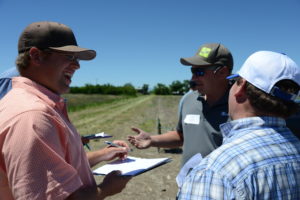National Crop and Insurance Services (NCIS) is on the road this year to speak first-hand with farmers, ranchers and insurance adjusters across the country about the unique challenges they face and the importance of crop insurance. The consensus is clear—crop insurance is one tool that farmers simply cannot do without.
In this What’s Cropping Up, we are pleased to share profiles of farmers and ranchers in Colorado.
Steve Wooten

Steve Wooten operates Beatty Canyon Ranch in northeast Las Animas County. Earlier this year, his family ranch was awarded the Colorado Leopold Conservation Award, which recognizes agricultural landowners actively committed to a land ethic.
Being stewards of the land is something that has always been important to the Wootens, who have made great progress in conservation methods over the years.
But, as Wooten noted, unfortunately, no amount of innovation can protect farmers from variables like weather. For the last 20 years, persistent drought situations have affected his cow-calf operation.
“Thankfully, today we do have some tools in place to help deal with these types of weather-related risks. One of the most important tools is an efficient crop insurance program for our nation’s farmers and ranchers,” Wooten said.
On Beatty Canyon Ranch, fourth, fifth and even sixth generations are involved in day-to-day operations, and the family’s ranching history stretches back to when Wooten’s great-grandfather immigrated from Ireland. While this may sound impressive, it is not uncommon among farm families.
“We are doing our part, and I urge Congress to do its part by passing a new Farm Bill with crop insurance intact. It, along with our ongoing conservation efforts, will ensure that farmers and ranchers will have a legacy to pass down to future generations,” Wooten said.
Watch his video story here.
Tim Brown

Tim Brown, of Limon, Colorado, is a third-generation farmer. His dad started the farm in 1956. But his father suffered two hailstorms in a row that effectively closed the farm and forced him to work elsewhere.
Brown says he faces some of the same issues today that his family faced when he was growing up, including fluctuating markets, trade issues and, of course, Mother Nature.
“This is the importance of the crop insurance. If we didn’t have the crop insurance, I don’t know what we would do,” Brown said.
Brown noted that many people don’t realize crop insurance only covers a farmer’s costs – at best.
“It just barely covers my cost to put that crop in the ground. Just barely,” he said.
Watch his video story here.
Brad Rock

Brad Rock has been farming in Wray, Colorado, for 20 years. His family grows several crops, raises cattle and runs a trucking operation.
“We do it because we love it,” Rock said. “We get to provide a quality product to the consumer that we feel comfortable growing and raising.”
His son, Alex, went to college and came home to help on the farm, particularly on the technology side. His dad says it is his calling.
But Rock notes that one of the current challenges his family farm faces is an increase in input costs, including seed fertilizer, rent, equipment and employee costs.
“If we were not to have crop insurance and we would lose a crop, we don’t have any way to recoup any of our input costs,” Rock said.
This year, Rock’s farm lost nine quarters of ground, including wheat, sunflowers, millet and corn – all in one afternoon storm. A week later, the farm lost another quarter.
“If we didn’t have (crop) insurance, we would be in a world of hurt,” Rock said. “Not only do we depend on that to pay for our expenses, but we have seven other employees that work for us.”
Programs like crop insurance also help keep food prices low for consumers, Rock noted.
Watch his video story here.
Our series continues soon in Montana so be sure to check back at cropinsuranceinmystate.org for more great stories to watch and share.










